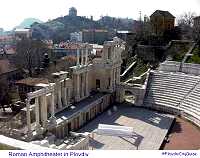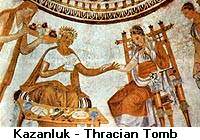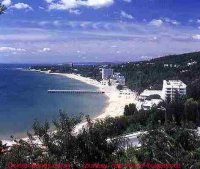Bulgaria is a country with many attractions: beautiful mountains offering
hiking in summer and skiing in winter, ancient
monasteries, summer resorts with golden,
sandy beaches, and an interesting folklore and historic relics. It is relatively inexpensive to visit, because prices have
not yet caught up with those of western Europe.
 Plovdiv is Bulgaria's second largest city, known for its annual international trade fair. However, it is also a rich cultural center, because it was the capital of the Roman province, Thracia. In summer plays are still performed in the well preserved remains of a Roman amphitheater. The Plovdiv
Archeological Museums contains the Panagyuriste gold treasure (4th. century B.C.), a set of nine exquisitely shaped Thracian vessels - rhytons, amphoras and a phial - all embossed with mythological scenes.
Plovdiv is Bulgaria's second largest city, known for its annual international trade fair. However, it is also a rich cultural center, because it was the capital of the Roman province, Thracia. In summer plays are still performed in the well preserved remains of a Roman amphitheater. The Plovdiv
Archeological Museums contains the Panagyuriste gold treasure (4th. century B.C.), a set of nine exquisitely shaped Thracian vessels - rhytons, amphoras and a phial - all embossed with mythological scenes.
Plovdiv is also the natural gateway to the magnificent
Rhodopes Mountains and the mountain resort
Pamporovo These mountains are much greener and not as high as the others, although many peaks are close to 2,000 m. They offer many good opportunities for hiking. Among the attractions are several lakes, both natural and artificial.
The other great Bulgarian monastery is
Bachkovo. Its architecture, magnificent paintings and icons are renowned. It is likewise located in thsee mountains, just over an hour by car or tour bus from Plovdiv.
205km. due east of Sofia, or 130km. north-east of Plovdiv, lies the town of
Kazanluk.
 It is the center of the Valley of Roses, Europe's largest producer of
rose oil used in perfumes. The first week of June the Rose Festival is held at the peak of the harvest.
It is the center of the Valley of Roses, Europe's largest producer of
rose oil used in perfumes. The first week of June the Rose Festival is held at the peak of the harvest.
But, even more important, it is also the site of an ancient
Thracian city that thrived about 500 B.C. (contemporary to ancient Greece). Many of the tombs have been uncovered. The tombs, beehive shaped, contain marvelously preserved wall paintings.
Stara Zagora, 46km. south of Kazanluk, is the site of an even older settlement dating back to 5,000BC. The excavations may be viewed. The town was more recently a Roman provincial center, and the Roman forum, baths and walls are well preserved.
You may cross the Balkan Mountain range by the Shipka Pass to reach  Veliko Turnovo is the site of the last and finest of the medieval Bulgarian capitals, of the Second Bulgarian Kingdom. It was built in the 12th. century on three steep hills overlooking the Yatra river. The walls and parts of the palace, on Tsaravets hill, have been restored. The town, with many old buildings and churches is a UNESCO World Heritage site. In the summer, a Sound and Light show provides a historical spectacle.
Veliko Turnovo is the site of the last and finest of the medieval Bulgarian capitals, of the Second Bulgarian Kingdom. It was built in the 12th. century on three steep hills overlooking the Yatra river. The walls and parts of the palace, on Tsaravets hill, have been restored. The town, with many old buildings and churches is a UNESCO World Heritage site. In the summer, a Sound and Light show provides a historical spectacle.
Three km. to the east, in
Arbanassi you may view old 15th. century houses with carved wooden ceilings. Here also, two monasteries filled with rich icons may be viewed.
140km. further east, on the road to Varna, Shumen is home to the second largest mosque in Bulgaria. A Thracian and Roman fortress overlooks the town. The town is a convenient base for viewing the two earliest Bulgarian capitals:-
Preslav , which was the capital of Tsar Simeon I, the ruler of the First Bulgarian Kingdom in the 11th. century. Artifacts may be seen in the museum, but only foundations remain of the ancient palace and fortress. The mosaic floor of the great cathedral may also be seen.
Pliska was the first capital of the Bulgarian khans after they settled down at the end of the 7th. century A.D.
Very little remains of the Basilica that was built after conversion to Christianity in the 9th. century. However, a few miles away, the rock carvings of the Madara Horsemen may be viewed. They date back to the same time period.
 The golden Black Sea beaches attract thousands of west European tourists every year, because thay are not only great expanses of soft sand, but also the resorts are much less expensive than those of France and Italy. There are two major concentrations of resorts:-
The golden Black Sea beaches attract thousands of west European tourists every year, because thay are not only great expanses of soft sand, but also the resorts are much less expensive than those of France and Italy. There are two major concentrations of resorts:-
In the north, close to the port city
Varna - Albena, Golden Sands and several others.
In the south close to the port of Burgas - Sunny Beach, Dyuni, Nessebar and others.
All these resorts offer a wide range of facilities and entertainment, as well as awide range of accomodations from luxury hotels, to holiday camps and villas.
How to get there. Several airlines provide service to Sofia from hubs in Europe. In summer there is also air service to Burgas and Varna from several European hubs. Bus service is available from Budapest, Vienna and several other cities. Rail connections from other countries are slow. The direct service from Vienna and Budapest, via Beograd has now been restored, but takes about 20 hours from Vienna to Sofia.
Within Bulgaria there is good train service to all major cities, otherwise there are bus connections.
Return to Top of page.
Return to Part 1 Sofia, Monasteries and Mountain Resorts
Return to Travel pages Index



 It is the center of the Valley of Roses, Europe's largest producer of
rose oil used in perfumes. The first week of June the Rose Festival is held at the peak of the harvest.
It is the center of the Valley of Roses, Europe's largest producer of
rose oil used in perfumes. The first week of June the Rose Festival is held at the peak of the harvest.

